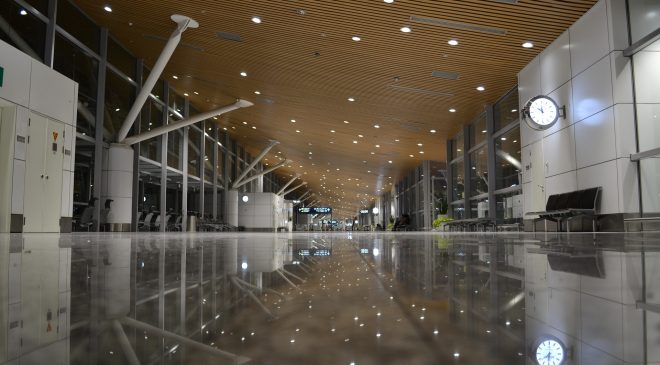
The flat market and pandemic impacts are driving new behaviours.
The International Air Transport Association (IATA) has warned of potential airport chaos unless governments move quickly to adopt digital processes to manage travel health credentials (COVID-19 testing and vaccine certificates) and other COVID-19 measures.
The impacts will be severe:
Pre-COVID-19, passengers, on average, spent about 1.5 hours in travel processes for every journey (check-in, security, border control, customs, and baggage claim).
Current data indicates that airport processing times have ballooned to 3.0 hours during peak time with travel volumes at only about 30% of pre-COVID-19 levels. The greatest increases are at check-in and border control (emigration and immigration) where travel health credentials are being checked mainly as paper documents.
Modeling suggests that, without process improvements, the time spent in airport processes could reach 5.5 hours per trip at 75% pre-COVID-19 traffic levels, and 8.0 hours per trip at 100% pre-COVID-19 traffic levels.
Without an automated solution for COVID-19 checks, we can see the potential for significant airport disruptions on the horizon, said Willie Walsh, IATA’s Director General.
“Already, average passenger processing and waiting times have doubled from what they were pre-crisis during peak time—reaching an unacceptable three hours. And that is with many airports deploying pre-crisis level staffing for a small fraction of pre-crisis volumes. Nobody will tolerate waiting hours at check-in or for border formalities,” he said. “We must automate the checking of vaccine and test certificates before traffic ramps up. The technical solutions exist. But governments must agree digital certificate standards and align processes to accept them. And they must act fast.”
In a report by Nokia over the last decade, a host of new terms have proliferated the aviation business, including ‘smart airport’, ‘self-service’, ‘connected traveller’, ‘location-based services’ etc. Connectivity forms the bedrock of all such applications. It links equipment, resources and assets, the Internet of Things (IoT) and enables data sharing from the farthest corners of the airport.
Transitioning to a digital environment requires a holistic approach involving two important areas of any airport. The airside comprising of the apron, taxiway, runway and the zone beyond security, passport and customs control, like duty-free, lounges and boarding gates. Next is the landside consisting of the terminal buildings, parking bays, roads and public transport network.
Taking off for Airport 4.0
Airport 4.0 is the air transport hub of the future. Using the latest advancement in wireless and wireline connectivity, automation, artificial intelligence (AI), robotics and digital twins this wave of digitalization is set to take operational and situational awareness to a whole new level, reduce costs and generate diverse forms of non-aeronautical revenues.
The impact would be deep and wide. Hardly any segment would go untouched. Private wireless networks ensuring safe and efficient tarmac operations, cargo management and surveillance. Biometric readers screening passengers, automated systems tagging luggage, journey trackers providing real-time updates and remote border control carrying out immigration checks.
Consequently, airports would also seek to revisit current LAN practices. Airport LAN typically uses copper-based CATx switches, which require equipment closets every 600 feet to overcome the distance limitations of CATx cable. The latest LAN technologies use fiber and support terabits of data and miles of distance. They remove the need for equipment closets and protect airports’ investment in passive infrastructure.
“Connectivity can no longer be treated as a commodity. It is a strategic asset that is as important to an airport as the runway,” said Richard van Wijk, Global Public Safety & Aviation Practice Lead at Nokia.
According to the IATA if governments require COVID-19 health credentials for travel, integrating them into already automated processes is the solution for a smooth restart. This would need globally recognized, standardized, and interoperable digital certificates for COVID-19 testing and vaccine certificates.
Digitalized certificates have several advantages:
- Avoiding fraudulent documentation
- Enabling advance “ready-to-fly” checks by governments
- Reducing queuing, crowding and waiting time in airports through integration with self-service check-in (via the internet, kiosks or mobile phone apps)
- Increasing security through integration with digital identity management being used by border control authorities
- Reducing the risk of f virus transmission via the person-to-person exchange of paper documents
- Building a Global Approach
- The G20 has identified a similar solution. The G20 Rome Guidelines for the Future of Tourism call for a common international approach on COVID-19 testing, vaccination, certification, and information as well as promoting digital traveller identity.
The G7 discussions, which commence on 11 June, are the next opportunity for leading governments to develop a solution around four key actions by agreeing to:
- Issue vaccination certificates based on World Health Organization (WHO) Smart Vaccine Certificate data standards including QR codes
- Issue COVID-19 test certificates in accordance with the data requirements set out by the International Civil Aviation Organization (ICAO)
- Accept digital COVID-19 test and vaccine certificates at their borders
Where governments require airlines to check travel credentials, governments should accept traveler friendly apps, such as the IATA Travel Pass, to efficiently facilitate the process.
This cannot wait. More and more people are being vaccinated. More borders are opening. Booking patterns tell us that pent-up demand is at extremely high levels. But governments and the competent authorities are acting in isolation and moving far too slowly. A smooth restart is still possible. But governments need to understand the urgency and act fast,” said Walsh.
IATA asks the G7 to work with the air transport industry to take leadership in restarting the global travel sector. By engaging with the air transport industry, we can ensure that government requirements for safe travel are met with solutions that can be efficiently operationalized.
“A good first step would be G7 agreement, with industry input, on a common set of COVID-19 travel requirements. The next step would be implementing and mutually recognizing those requirements.
If the G7 took these leadership measures , the freedom to travel could be seamlessly restored for about a third of all journeys. Other countries could build on that leadership for a safe and efficient global restart of connectivity,” said Walsh.
Nokia notes that As wireless technology matures, enterprises have started to use purpose-built secure private wireless networks. Based on 4G or 5G, it supports services that allow airports to enable applications in a secure and reliable way. Moreover to remove operational complexity such private networks can be offered as a service with the airport having full autonomy in terms of scaling the network. Essentially, a private wireless network creates the very foundation for Airport 4.0 by making it simpler to embrace process digitalization and ditch paper and pencil.
Apart from these distinct benefits, private wireless allows better operational and situational awareness, boosting incident response and minimizing the impact on turnarounds. The airport operations center (APOC) mainly relies on verbal push-to-talk communications. At airside, it often fails to follow an incident that occurs beyond the CCTV’s field of vision.
This problem can be resolved by intelligent application-based solutions that would communicate with remotely controlled pan-tilt-zoom cameras fitted on marshal cars or first responder vehicles, allowing the APOC to accelerate decision-making. Airports can even capitalize on a monetization opportunity by offering these services to their stakeholders in a multi-tier subscription model.




